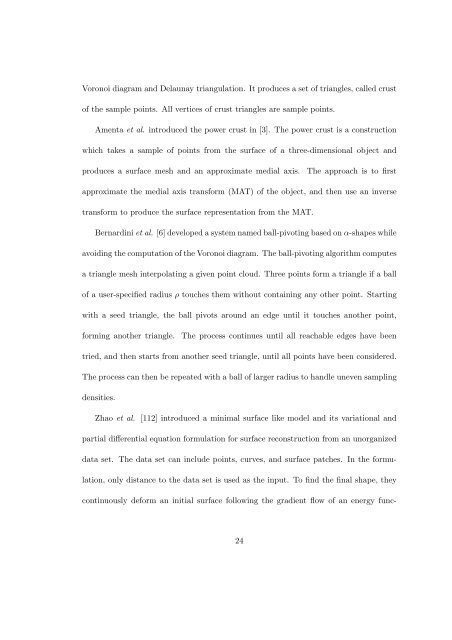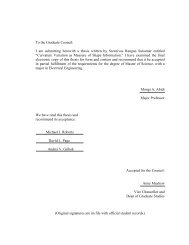To the Graduate Council: I am submitting herewith a dissertation ...
To the Graduate Council: I am submitting herewith a dissertation ...
To the Graduate Council: I am submitting herewith a dissertation ...
You also want an ePaper? Increase the reach of your titles
YUMPU automatically turns print PDFs into web optimized ePapers that Google loves.
Voronoi diagr<strong>am</strong> and Delaunay triangulation. It produces a set of triangles, called crustof <strong>the</strong> s<strong>am</strong>ple points. All vertices of crust triangles are s<strong>am</strong>ple points.Amenta et al. introduced <strong>the</strong> power crust in [3]. The power crust is a constructionwhich takes a s<strong>am</strong>ple of points from <strong>the</strong> surface of a three-dimensional object andproduces a surface mesh and an approximate medial axis.The approach is to firstapproximate <strong>the</strong> medial axis transform (MAT) of <strong>the</strong> object, and <strong>the</strong>n use an inversetransform to produce <strong>the</strong> surface representation from <strong>the</strong> MAT.Bernardini et al. [6] developed a system n<strong>am</strong>ed ball-pivoting based on α-shapes whileavoiding <strong>the</strong> computation of <strong>the</strong> Voronoi diagr<strong>am</strong>. The ball-pivoting algorithm computesa triangle mesh interpolating a given point cloud. Three points form a triangle if a ballof a user-specified radius ρ touches <strong>the</strong>m without containing any o<strong>the</strong>r point. Startingwith a seed triangle, <strong>the</strong> ball pivots around an edge until it touches ano<strong>the</strong>r point,forming ano<strong>the</strong>r triangle.The process continues until all reachable edges have beentried, and <strong>the</strong>n starts from ano<strong>the</strong>r seed triangle, until all points have been considered.The process can <strong>the</strong>n be repeated with a ball of larger radius to handle uneven s<strong>am</strong>plingdensities.Zhao et al. [112] introduced a minimal surface like model and its variational andpartial differential equation formulation for surface reconstruction from an unorganizeddata set. The data set can include points, curves, and surface patches. In <strong>the</strong> formulation,only distance to <strong>the</strong> data set is used as <strong>the</strong> input. <strong>To</strong> find <strong>the</strong> final shape, <strong>the</strong>ycontinuously deform an initial surface following <strong>the</strong> gradient flow of an energy func-24
















